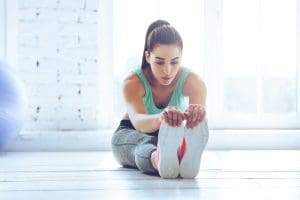 Studies show that sleep has an effect on the way we feel on a daily basis and our overall health. Therefore lack of sleep can weaken our immune system. You can get a better night’s sleep by adding some stretches to your bedtime routine. Continue reading to learn the benefits of daily stretching as well as a guideline to reduce stress and boost relaxation.
Studies show that sleep has an effect on the way we feel on a daily basis and our overall health. Therefore lack of sleep can weaken our immune system. You can get a better night’s sleep by adding some stretches to your bedtime routine. Continue reading to learn the benefits of daily stretching as well as a guideline to reduce stress and boost relaxation.
If you are one of 50 to 70 million Americans suffering from a sleep disorder or are one of the almost 40% of adults who report that they don’t get enough sleep, per the National Institutes of Health, you are well aware that the way you feel each day depends, in part, on the way you sleep each night.
In fact, getting enough quality sleep doesn’t only impact how you feel; it affects your overall health. According to the NIH, a lack of quality sleep can lead to diminished immune system functioning and is associated with a higher risk of obesity, diabetes, heart disease, depression and anxiety.
The good news is that by adding some simple stretches to your bedtime routine, you can get a better night’s sleep. Studies, such as a 2019 one published in the Brazilian Journal of Psychiatry, have shown that stretching can help improve insomnia and increase muscle relaxation for a better night’s sleep.
8 Stretches to Include in Your Bedtime Routine
This series includes gentle stretches to help you unwind from your day, reduce stress and relax for a better night’s sleep. It begins with standing stretches to help reverse the c-curve, or desk posture, that your body gravitates toward after a long day, then moves to lying stretches you can do on a mat, or even in your bed, just before sleep.
1. Doorway Stretch
After working on a computer, being on your phone or even driving your car, your shoulders are in a forward posture, and the muscles in your chest are shortened and tightened, which can lead to stiffness and pain in the neck, shoulders and upper back.
Utilize the doorway stretch to improve posture and reduce the discomfort that can inhibit quality sleep. As you are walking through a doorway, simply place the palms of both hands on the door frame, palms facing forward, and step through the doorway while keeping your hands in place. You should begin to feel a stretch in your chest and shoulders. Walk forward as far as you are able to in order to deepen the stretch.
2. Hip Flexor Stretch
When you sit for long periods of time, your hip flexors become tight. These extended periods of hip flexion need to be countered with hip extension to reduce the risk of developing low back pain.
Further, yoga practitioners often associate tightness in the hips with stored emotions. For some, hip stretches and hip openers can reduce stress by releasing emotional muscle tension and improving sleep.
Try the easy hip stretch: Step one foot forward so that you are in a lunge posture with your hips and toes facing forward, a bend in the front knee and a slight bend in the back knee. The front foot is firmly planted into the mat with the weight in the front heel. The back foot is in a heel-up position with the weight in the ball of the foot and the heel off of the floor.
Look down at your front foot to make sure that you can see your toes—if the front knee is out over the toes, it puts too much pressure on the knee joint. If you find yourself in that posture, simply shift your weight backward so that your torso is centered between your feet.
Gradually bring the back knee to the floor and allow the back foot to relax down onto the floor or mat to release the hip flexor. Once in this posture, allow your body weight to sink into your legs to deepen the stretch. Hold the stretch as long as you’d like, then repeat on the opposite side.
Click here to continue reading
Original article published on eatingwell.com








